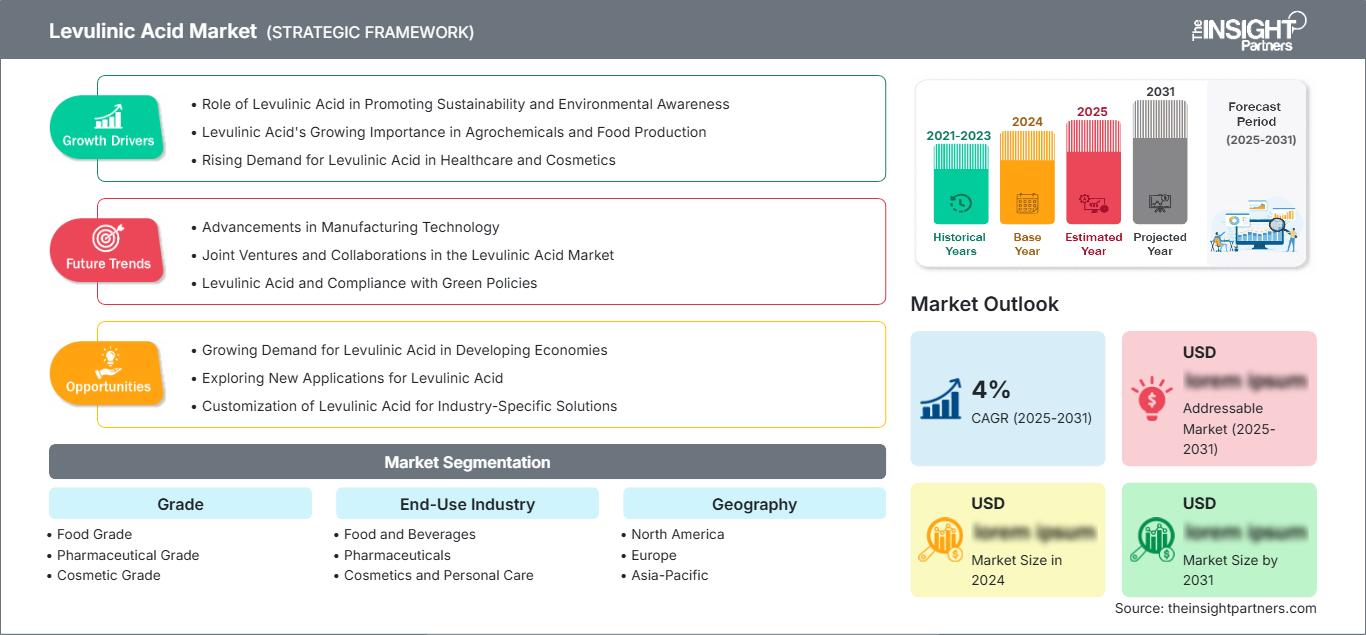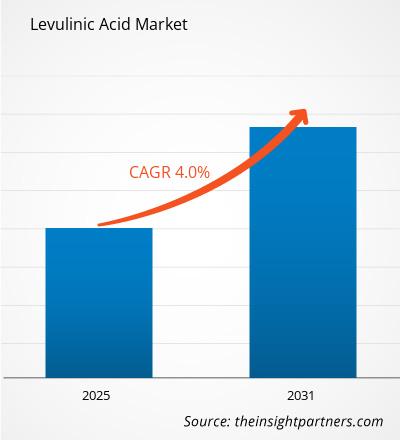Si prevede che il mercato dell'acido levulinico registrerà un CAGR del 4% dal 2025 al 2031, con una dimensione del mercato in espansione da XX milioni di dollari nel 2024 a XX milioni di dollari entro il 2031.
Il rapporto è segmentato per grado (alimentare, farmaceutico e cosmetico). Il rapporto presenta inoltre un'analisi basata sul settore di utilizzo finale (alimenti e bevande, prodotti farmaceutici, cosmetici e cura della persona, agricoltura e altri). L'analisi globale è ulteriormente suddivisa a livello regionale e per i principali paesi. Le dimensioni e le previsioni del mercato a livello globale, regionale e nazionale per tutti i principali segmenti di mercato sono trattate nell'ambito di applicazione. Il rapporto fornisce il valore in USD per l'analisi e i segmenti sopra indicati. Il rapporto fornisce statistiche chiave sullo stato del mercato dei principali attori e offre tendenze e opportunità di mercato.
Scopo del rapporto
Il rapporto "Levulinic Acid Market" di The Insight Partners mira a descrivere il panorama attuale e la crescita futura, i principali fattori trainanti, le sfide e le opportunità. Ciò fornirà spunti a vari stakeholder aziendali, come:
- Fornitori/Produttori di tecnologia: per comprendere le dinamiche di mercato in evoluzione e conoscere le potenziali opportunità di crescita, consentendo loro di prendere decisioni strategiche informate.
- Investitori: per condurre un'analisi completa delle tendenze in merito al tasso di crescita del mercato, alle proiezioni finanziarie di mercato e alle opportunità esistenti lungo la catena del valore.
- Enti di regolamentazione: per regolamentare le politiche e le attività di controllo sul mercato con l'obiettivo di ridurre al minimo gli abusi, preservare la fiducia degli investitori e sostenere l'integrità e la stabilità del mercato.
Grado di segmentazione del mercato dell'acido levulinico
- Grado alimentare
- Grado farmaceutico
- Grado cosmetico
Industria di utilizzo finale
- Alimenti e bevande
- Prodotti farmaceutici
- Cosmetici e cura della persona
- Agricoltura
Potrai personalizzare gratuitamente qualsiasi rapporto, comprese parti di questo rapporto, o analisi a livello di paese, pacchetto dati Excel, oltre a usufruire di grandi offerte e sconti per start-up e università
Mercato dell'acido levulinico: Approfondimenti strategici

-
Ottieni le principali tendenze chiave del mercato di questo rapporto.Questo campione GRATUITO includerà l'analisi dei dati, che vanno dalle tendenze di mercato alle stime e alle previsioni.
Fattori di crescita del mercato dell'acido levulinico
- Ruolo dell'acido levulinico nella promozione della sostenibilità e della consapevolezza ambientale: la crescente attenzione alla sostenibilità, alla consapevolezza ambientale e alla mitigazione dei cambiamenti climatici sta aumentando la popolarità di prodotti biochimici come l'acido levulinico. Ciò è alimentato, in parte, dalle crescenti preoccupazioni industriali sul riscaldamento globale e sui combustibili fossili e persino dalle richieste di utilizzo di fonti di risorse non esauribili. L'acido levulinico, noto anche come acido gamma-chetovalerico, è prodotto da fonti rinnovabili come la biomassa lignocellulosica, il che lo rende un'alternativa ecologica ai prodotti chimici a base di petrolio. Poiché l'acido levulinico presenta tutte le qualità ricercate o richieste da vari settori industriali, non sorprende che le sue applicazioni siano vaste, soprattutto nei settori farmaceutico e agrochimico, dove molte aziende sono alla ricerca di biopesticidi.
- Crescente importanza dell'acido levulinico nell'agrochimica e nella produzione alimentare: la crescita dell'industria agrochimica incoraggia anche i produttori ad aumentare la domanda di acido levulinico. Esiste una domanda di acido levulinico come componente fondamentale nella produzione di vari agrochimici come erbicidi, insetticidi e fungicidi. La popolazione mondiale in continua crescita crea un bisogno insaziabile di produzione alimentare. Ciò costringe agricoltori e produttori di agrochimici a cercare modi migliori per aumentare la produzione alimentare e gestire le minacce rappresentate dai parassiti. Ciò stimolerà la crescita del mercato con una maggiore domanda di prodotti agrochimici a base di acido levulinico di origine biologica.
- Crescente domanda di acido levulinico nel settore sanitario e cosmetico: si prevede un'impennata della domanda di acido levulinico nei settori sanitario e cosmetico grazie alla versatilità del composto. I principi attivi farmaceutici (API) utilizzano l'acido levulinico come reagente nei loro processi di produzione e il composto è presente anche nei cosmetici come estratto di rosa bulgara. Si sta inoltre verificando una tendenza verso prodotti sani e "clean-label", alimentando l'utilizzo di prodotti biologici in tali settori. Il sentiment del mercato è quindi riluttante nei confronti di un contenimento malsano e dannoso, e quindi l'uso dell'acido levulinico è preferito dai produttori.
Tendenze future del mercato dell'acido levulinico
- Progressi nella tecnologia di produzione: i recenti sviluppi nella tecnologia di produzione contribuiscono a migliorare la produttività e a ridurre i costi di produzione dell'acido levulinico. Ad esempio, l'introduzione di processi catalitici e la ricerca sulle condizioni di reazione ottimizzate vengono impiegate per aumentare la produzione riducendo al contempo l'apporto energetico. Tali progressi consentono di produrre acido levulinico in modo economicamente più vantaggioso e con un minore consumo di risorse. Con il miglioramento dei processi tecnologici nel tempo, si prevede che l'acido levulinico sarà disponibile ed economico, poiché la sua elevata domanda stimolerà la crescita del mercato.
- Joint venture e collaborazioni nel mercato dell'acido levulinico: nel mercato dell'acido levulinico, si registra un aumento del numero di aziende, istituti di ricerca e aziende agricole che stipulano joint venture. Tali alleanze facilitano la condivisione di conoscenze e risorse per creare nuove applicazioni o migliorare quelle esistenti. Ad esempio, le collaborazioni orientate alla ricerca possono portare a una maggiore penetrazione del mercato dell'acido levulinico, individuando nuove aree di applicazione in diversi settori di utilizzo finale. Ciò è importante per promuovere lo sviluppo e migliorare la posizione di mercato.
- Acido levulinico e conformità alle politiche ambientali: con l'inasprirsi degli standard di tutela ambientale negli ultimi tempi, i produttori sono tenuti a rispettare le politiche ambientali. Lo sviluppo favorevole dell'acido levulinico come sostanza chimica di origine biologica è in linea con le attuali politiche orientate verso una chimica e processi di produzione più ecologici. Le aziende stanno inoltre svolgendo ricerche per mantenere la politica regolamentare e garantire che i consumatori siano soddisfatti delle diverse applicazioni dell'acido levulinico.
Opportunità di mercato dell'acido levulinico
- Crescente domanda di acido levulinico nelle economie in via di sviluppo: il mercato dell'acido levulinico ha un ampio potenziale di crescita nelle economie in via di sviluppo, in particolare nelle regioni dell'Asia-Pacifico, dell'America Latina e dell'Africa. La domanda di prodotti chimici di origine biologica in queste aree è in crescita a causa della rapida industrializzazione, del miglioramento delle pratiche agricole e del crescente potere d'acquisto della popolazione. Questa è un'opportunità per le aziende di procedere e creare stabilimenti di produzione e canali di distribuzione volti a servire questi mercati e ad aumentare la propria quota di mercato.
- Esplorazione di nuove applicazioni per l'acido levulinico: i produttori hanno maggiori possibilità di avventurarsi in nuove aree dell'acido levulinico, diverse dalle sue applicazioni note. Tali applicazioni possono includere bioplastiche, agenti antimicrobici e sostanze aromatizzanti per alimenti. Le aziende possono sfruttare l'equilibrio tra ricerca e sviluppo per creare nuovi concetti di utilizzo dell'acido levulinico, conformi alle norme di mercato e alle richieste degli acquirenti, al fine di aumentare i ricavi.
- Personalizzazione dell'acido levulinico per soluzioni specifiche del settore: con l'avvento dell'industrializzazione, la ricerca di una soluzione a un determinato problema nel settore è diventata più snella. I produttori possono ricostituire i componenti dell'acido levulinico per adattarli a un settore specifico. Ciò comporta la creazione di forme uniche di acido levulinico per farmaci, agricoltura o prodotti di bellezza. Un'azienda può ottenere un vantaggio competitivo e migliorare la fedeltà dei clienti offrendo questo tipo di servizio.
Mercato dell'acido levulinico
Le tendenze regionali e i fattori che influenzano il mercato dell'acido levulinico durante il periodo di previsione sono stati ampiamente spiegati dagli analisti di The Insight Partners. Questa sezione illustra anche i segmenti e la geografia del mercato dell'acido levulinico in Nord America, Europa, Asia-Pacifico, Medio Oriente e Africa, America meridionale e centrale.
Ambito del rapporto di mercato dell'acido levulinico
| Attributo del rapporto | Dettagli |
|---|---|
| Dimensioni del mercato in 2024 | US$ XX million |
| Dimensioni del mercato per 2031 | US$ XX Million |
| CAGR globale (2025 - 2031) | 4% |
| Dati storici | 2021-2023 |
| Periodo di previsione | 2025-2031 |
| Segmenti coperti |
By Grado
|
| Regioni e paesi coperti |
Nord America
|
| Leader di mercato e profili aziendali chiave |
|
Densità degli attori del mercato dell'acido levulinico: comprendere il suo impatto sulle dinamiche aziendali
Il mercato dell'acido levulinico è in rapida crescita, trainato dalla crescente domanda da parte degli utenti finali, dovuta a fattori quali l'evoluzione delle preferenze dei consumatori, i progressi tecnologici e una maggiore consapevolezza dei benefici del prodotto. Con l'aumento della domanda, le aziende stanno ampliando la propria offerta, innovando per soddisfare le esigenze dei consumatori e sfruttando le tendenze emergenti, alimentando ulteriormente la crescita del mercato.

- Ottieni il Mercato dell'acido levulinico Panoramica dei principali attori chiave
Punti di forza
- Copertura completa: il rapporto copre in modo completo l'analisi di prodotti, servizi, tipologie e utenti finali del mercato dell'acido levulinico, fornendo un panorama olistico.
- Analisi di esperti: il rapporto è compilato sulla base della conoscenza approfondita di esperti e analisti del settore.
- Informazioni aggiornate: il rapporto garantisce rilevanza aziendale grazie alla sua copertura di informazioni recenti e tendenze dei dati.
- Opzioni di personalizzazione: questo rapporto può essere personalizzato per soddisfare le esigenze specifiche del cliente e adattarsi in modo appropriato alle strategie aziendali.
Il rapporto di ricerca sul mercato dell'acido levulinico può, quindi, aiutare a guidare il percorso di decodificazione e comprensione dello scenario del settore e delle prospettive di crescita. Sebbene possano esserci alcune preoccupazioni valide, i vantaggi complessivi di questo rapporto tendono a superare gli svantaggi.
- Analisi storica (2 anni), anno base, previsione (7 anni) con CAGR
- Analisi PEST e SWOT
- Valore/volume delle dimensioni del mercato - Globale, Regionale, Nazionale
- Industria e panorama competitivo
- Set di dati Excel
Report recenti
Rapporti correlati
Testimonianze
Motivo dell'acquisto
- Processo decisionale informato
- Comprensione delle dinamiche di mercato
- Analisi competitiva
- Analisi dei clienti
- Previsioni di mercato
- Mitigazione del rischio
- Pianificazione strategica
- Giustificazione degli investimenti
- Identificazione dei mercati emergenti
- Miglioramento delle strategie di marketing
- Aumento dell'efficienza operativa
- Allineamento alle tendenze normative






















 Ottieni un campione gratuito per - Mercato dell'acido levulinico
Ottieni un campione gratuito per - Mercato dell'acido levulinico